Cat & Rouse: when Robb Gravett and the Trakstar team took on the BTCC
Thirty years ago, Robb Gravett and the rag-tag Trakstar team took on the benchmark of the British Touring Car Championship, and used all of their nine lives to come out on top. Damien Smith tells their story
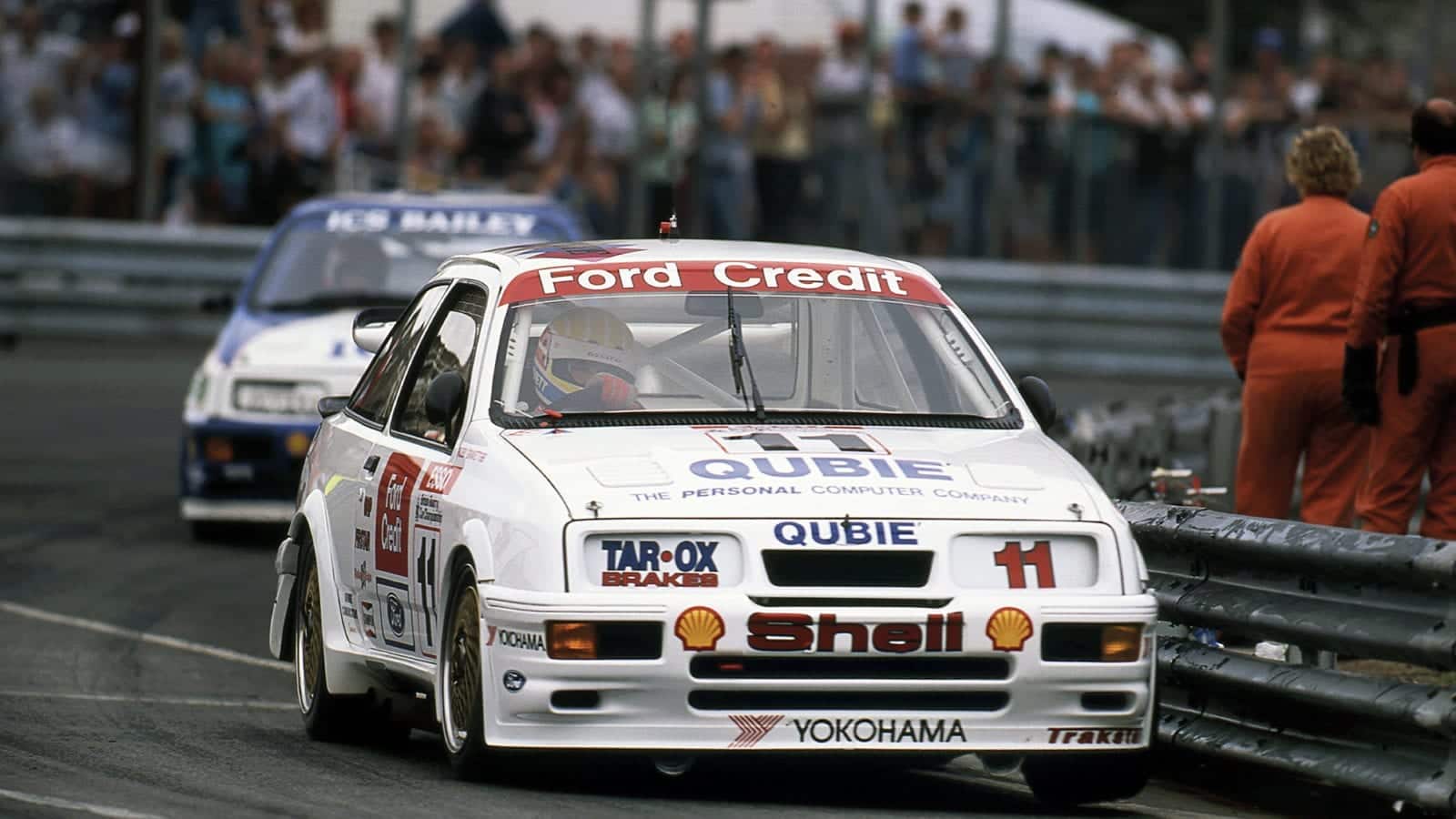
Gravett’s almost plain white RS500 heads Rouse’s more bedecked version during the Birmingham Superprix
Jakob Ebrey
The nervous smile is little more than a half-hearted attempt to break the tension. Perched on the plastic seats at the front of Donington’s pitlane garages, ashen-faced Robb
Gravett can barely look. No wonder. Stig Blomqvist, 1984 World Rally champion but hardly the most obvious choice of partner for an hour-long, two-driver British Touring Car Championship race, is just seconds away from victory in the bare white Ford Cosworth RS500 – and for Gravett and Trakstar there’s a great deal riding on it. The lack of stickers on the flanks of the steroidal saloon are the tell-tale. A £6000 Ford bonus for every RS500 race victory really counts and this being just the second round of the 1990 BTCC, with a long season stretching out ahead and not a sponsor bean in sight, the cash is crucial to get them to the next round.
He’s safely around the Melbourne loop. But David Sears, in for BTCC kingpin Andy Rouse in the smart, blue ICS-stickered RS500, is still right there. Stig charges down to Goddards – and shock-horror – dumps the lot by braking far too late, the white Cossie spinning clumsily to face the way it has just come. On the TV commentary, Murray Walker has sailed past his own breaking point as Sears calmly takes the corner and passes the chequer. If he’s smiling behind the wheel, that’s nothing compared to the utter glee spread over Rouse’s face in the pitlane. Further down the pit road, Gravett looks like he might be about to vomit.
Just another day, then, in the super-powered Group A era that kickstarted the BTCC boom. But this was not just another year. In 1990 – hard to believe it’s 30 years ago – Rouse vs Gravett provided the perfect swansong for Group A and the wondrous RS500s, offering up all the raw ingredients of a classic season: intense personal rivalry, a relative upstart taking on the establishment, will-he-make-it-or-won’t-he financial strife and fabulously overblown turbo track action. Then to add to the mix, in the final year for the traditional multi-class tin-top tomfoolery in which drivers buried in the midfield usually won the title, the bloke who won most of the races actually became overall champion, too – just as the BTCC was finally about to see sense and simplify it all with a single class, for 2-litre normally aspirated ‘shopping cars’. Oh the irony.
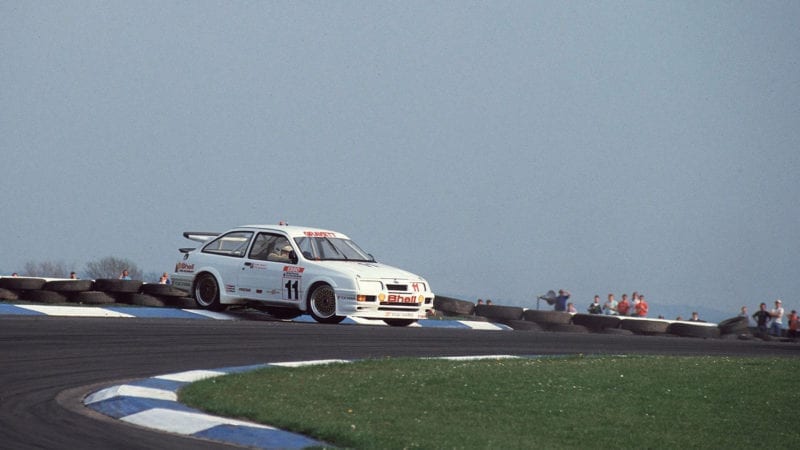
The moment it all went wrong. WRC star Stig Blomqvist loops it at Donington’s final turn to lose what would have been a valuable win for Trakstar and Gravett, and hands it to Rouse
John Colley
“Robb Gravett was a class act,” says Steve Rider, assured BTCC TV anchor both then for the BBC’s highlights coverage on Grandstand, and now for ITV4’s wall-to-wall live broadcasts.
“He’s a clever guy, but he represented what we love in the BTCC today: the image of someone who had stepped out of the crowd at Paddock Hill Bend, found himself a car and just got on with it.”
In fact, that’s almost as Gravett describes his BTCC entry, following his 1980s blitz on the production saloon car scene. After a 1987 in which he’d won Class A in both the Uniroyal and Munroe series, plus the Willhire 24 Hours at Snetterton with Graham Hathaway and Phil Bullman, Gravett found himself high and dry. “I was in trouble financially, but the next stage had to be Group A,” recalls the Londoner. “I went to the first BTCC round at Silverstone and just cried: what more do I have to do?” Then Peter Hall of ICS, long-time friend and backer of Rouse, rode over the horizon. “When he ran at Oulton Park I think the RS500 frightened him,” claims Gravett. “I had a call from Rouse who said ‘Peter’s not going to drive, do you want to test at Thruxton?’” On the back of that run, Gravett became a BTCC driver, indirectly via Rouse – but the seeds of their future rivalry were soon sown. If he wanted to take on and beat the four-time champion, Gravett knew he’d need to race on his own terms.
Behind the RS500s in that 1988 season, a familiar blond-haired chap from the telly was giving Prodrive Class B BMW M3 team-mate Frank Sytner something to think about as the car dealership franchise magnate worked his way towards the overall BTCC title. Mike Smith – face of Radio 1, Top of the Pops and, um, Noel’s House Party – was another production saloon graduate who had formed a friendship with Gravett. At Prodrive, team manager Malcolm Swetnam also saw much he liked in Smith, a genuine and passionate racing enthusiast. “I remember Mike saying to me early in the season that ever since he was a kid his ambition was to have his own race team,” Swetnam says. “He said to me, ‘if you’re going to do it, you’ve got to be in the big car’.” Trakstar was born – and Swetnam threw his lot in with the guy off the telly.
“Everyone said to us ‘you’ll never beat Rouse’, but it wasn’t rocket science.”
“The race team at Prodrive in those days was the poor relation [to the rally team] and I didn’t enjoy that a great deal,” he says. “I just wanted to run with the big dogs up the front. I felt I had to do it and got on great with Mike. He was very correct. He outran Frank a couple of times and if you can do that you’re no nerd. But it’s fashionable to knock people like him. He did it for all the right reasons.”
Trakstar would run a pair of RS500s in 1989 for Smith and Gravett, but these were not just any Cossies. As Swetnam recalls, Australian Dick Johnson had come over and “blown the doors off” Rouse and the Eggenberger Sierras in qualifying at the ’88 Tourist Trophy at Silverstone, so Trakstar approached the tin-top legend to buy a pair of his cars. “We got DJR1 and DJR2, and Mike paid for them,” says Swetnam. “They were built for the Australian tracks and therefore they were super-strong. The engines came over with Dick’s engineer Neil Lowe, who stayed for the first event. I think they ran on Avgas. David Mountain [of Mountune] was going to rebuild the DJR engines, but we quickly arrived at the conclusion we could build a different engine to run on UK pump fuel. We had Shell Supergreen, which arrived in barrels – we’ll say no more – and Dave built stonking engines. In two years I think there was one engine failure and that was from debris from another Sierra’s turbocharger. They were brilliant.”
The final ingredient were the tyres that Gravett brought to the mix, and increasingly through 1989 and emphatically during ’90 it gave Trakstar the spice it needed to take on and beat Rouse. “On my way back from Australia I called Yokohama and went to a blind meeting in Tokyo to do a deal to bring their tyres into this country,” says Gravett. The Japanese rubber was “terrible” on first contact at Thruxton, but he credits the late tyre engineer Bert Baldwin and a strong relationship with Yokohama for gaining a clear edge over the rival Pirellis Rouse was running. “It put Yokohama on the map,” he says.
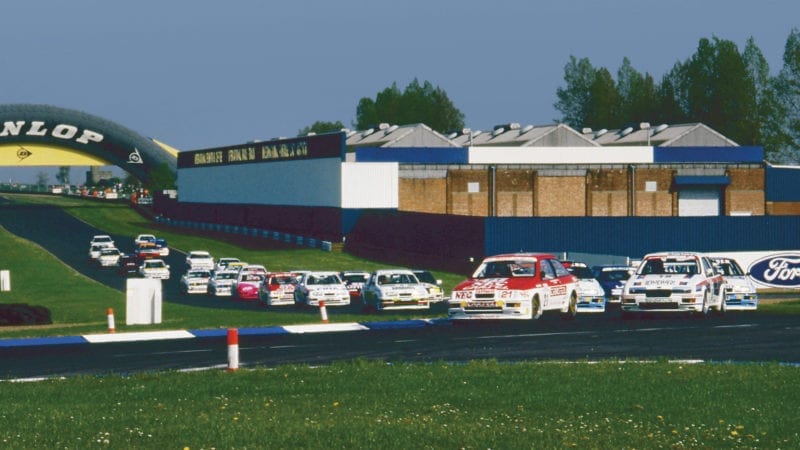
Gravett and team-mate Jeff Allam’s RS500 heads the field at the start of the 1989 BTCC one-hour enduro at Donington Park, but Laurence Bristow/ Tiff Needell would win in the Labatt’s entry
Jakob Ebrey
Andy Rouse Engineering never had it so good as the second half of the 1980s – but the boss grafted hard for his status as the best in the business. “We built something like 28 RS500s and they went all over the world,” he says. “We built more than 100 engines too and made and sent parts to Japan and Australia. Yes, the RS500 era was the best. We went all over the world racing cars at someone else’s expense, I had a factory employing 20 to 30 people and life was good, if hectic. We also did a limited edition road car at the same time as a spin-off from the racing, which worked well too.”
In contrast, Trakstar started with just five people, although two of them showed a bit of promise. “The guy who was number one mechanic on Robb’s car was Mark Ellis,” says Swetnam. “I found him driving a breakdown truck on the M4 when he applied for a job. He ended up as head of vehicle dynamics at Red Bull and is now at Mercedes F1. I’ve got a mad picture somewhere of a Snetterton pitstop with Ellis on the right-front wheel and Ron Meadows [now sporting director at Mercedes F1] on the other. Talk about an overqualified touring car team.”
Victory first time out for Gravett at Oulton boded well, but at Thruxton for the end of May Bank Holiday Monday meeting he crashed heavily at Segrave, leaving his team a monumental task to be ready for Silverstone the following weekend. “That was an epic week,” recalls Swetnam. “We missed free practice at Silverstone but the car arrived for qualifying. Rouse couldn’t believe it when we drove past his awning to go to scrutineering.” Just to rub it in, Gravett won the race.
By season’s end his four victories to Rouse’s five put Gravett right in contention for the Class A title. Typically of the era, John Cleland had swept a poorly supported Class C in his Vauxhall Astra to win the overall title –but in the top class it was all to play for in the Silverstone finale. But also typically, the duel ended in a clumsy collision, Rouse emerging from the then-new Woodcote dogleg with the lead and a sixth victory to become class champion – until the stewards took it away from him for an illegal turbo modification. He claims not to remember it today, but does at least recall winning the appeal – the following January. Not everything was better back then.
But heading into 1990 the tailwind was clearly with Trakstar. “Everyone said to us ‘you’ll never beat Rouse’,” says Swetnam, who would leave the team early that season. “This sounds arrogant, but it wasn’t rocket science.”
“Every lap we did with that car cost us £1000, so we didn’t test much.”
But the tailwind was about to turn into a headwind: Trakstar lost its sponsor. The team had backing in 1989 from mobile phone company Cartel, owned by the NEC corporation. “The second-year deal was for £330,000 and they refused to pay,” says Gravett. “They said ‘if you want the money sue us’, which is what we did. We won the case in the High Court, but Mike and I spent £100,000 doing so. They said ‘you can have £150,000 but if you want more than that we’ll just wind the company up and you’ll get nothing’. So effectively we got £150,000 back on £430,000. That happened during the 1990 season and we didn’t get the money until it was over.”
In the meantime, the team had decided to build a new ’shell for Gravett given that his Dick Johnson car, as Swetnam puts it, “had had more hits that Bill Haley”. He continues: “I re-worked the rollcage, but the whole thing was done by Brian Walsh up in Yorkshire. He seam-welded it, put the cage in. A lot of bits came off DJR2, but the whole rear suspension was new because we had a great relationship with Ford Motorsport Germany and zero relationship with Ford Motorsport UK – in fact they were obstructive in many ways. We ended up with virtually an Eggenberger rear end but with a DJR Ronnie Harrop differential. It was a lightweight Johnson car.”
“Out of the box it was three-tenths quicker than the old car around Oulton Park,” says Gravett, “just because the chassis was tighter and the shell wasn’t as tired. I’m sure it had been through a lot in Australia.”
But with no sponsor, Smith – the beating heart of Trakstar – took the big decision to stand down from driving in 1990, leaving the team to focus solely on Gravett. He did at least return to share a victory with his team-mate in the one-hour mid-season race at Brands Hatch, but Gravett will be forever grateful for the sacrifice of his friend, who died in 2014 from complications following heart surgery.
“He was very good to me,” says Robb. “Without Mike it would not have been possible to achieve what we did. He was instrumental in the success that year, I just happened to be the guy who could drive fairly quickly.”
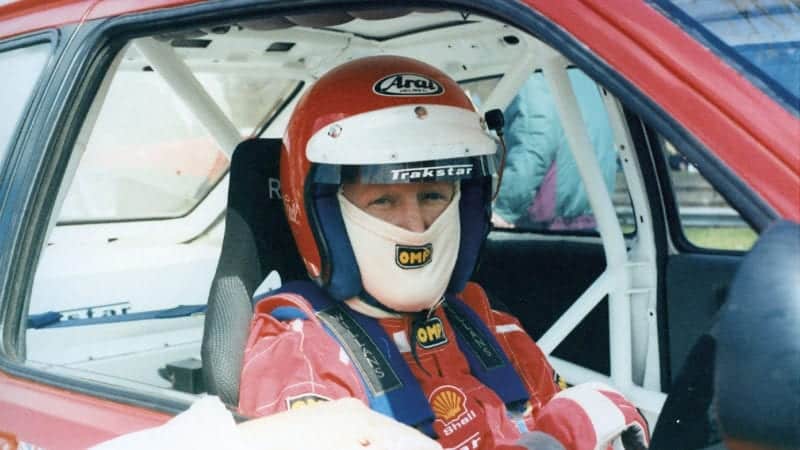
Mike Smith was a far better driver than he got credit for, but stepped back for 1990 to give Gravett his shot
The season kicked off at Oulton in April, with Gravett claiming the first of nine pole positions for the season. Rouse beat him in the race, then did so again thanks to that Blomqvist-shaped slice of luck at Donington. Trakstar needed a win if the campaign had any hope of making it to the summer. Thankfully, for Smith’s bank balance more than anything, Gravett and his Cossie then hit the rich seam of form the team was so desperate for, winning seven rounds on the trot. But throughout Rouse would be hot on their heels, the two RS500s tied as one.
“It wasn’t our greatest season,” says Rouse. “We were contracted to Pirelli and the tyres weren’t working so well for us. Robb was on Yokohamas which were better over a race distance. It made it interesting at least. Our tyres worked well in the first half of the race so I could often lead from the start, but Robb seemed to be able to catch me up in the end, which was down to rear tyre grip.”
While fighting Rouse on track, Gravett and Trakstar were still living hand to mouth, race to race. “If you look at the car through the year we actually put more sponsors on, but they weren’t big sponsors,” Gravett recalls. “Shell were good to us and a deal with Ford Credit helped, but it wasn’t anywhere near what we thought we were going to get for the season. Every lap we did with that car cost us £1000, so we didn’t test much.”
The duo won all the races between them, while Tim Harvey and Laurence Bristow played a supporting role in a pair of Rouse-run RS500s backed by beer brand Labatt’s. “Everyone who was involved at the time was sure it was down to the Yokohama tyres,” says Harvey. “No disrespect to Robb at all, but those cars always overcame their tyres, which were the limiting factor. They went off because they were just too powerful, around 560bhp by 1990, and tyre technology wasn’t what it is today. But Robb’s tyres always held up.”
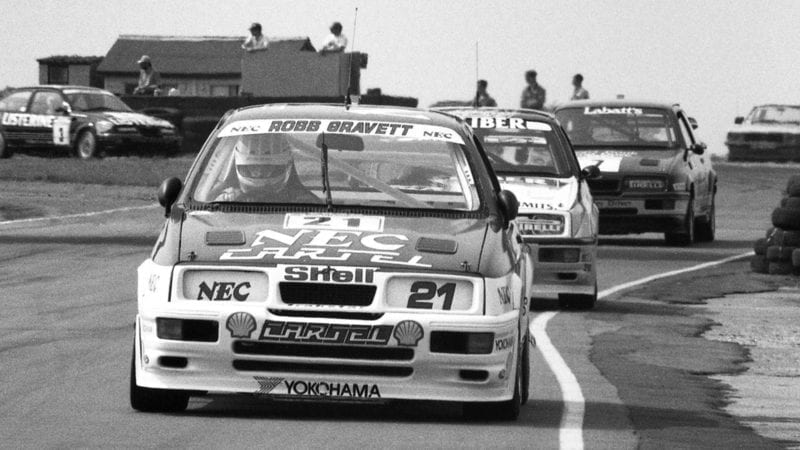
Four wins in 1989 set the scene for Gravett’s stunning 1990 season, where nine poles and nine wins from 13 races gave Trakstar the title
Harvey’s lack of wins left him frustrated, but he describes driving for Rouse as “an education”. “I still don’t think there has been anyone like Andy in touring cars,” he says. “His record we thought would be unsurpassed. It’s only because we now have three races per weekend and 30 a season that his records have been beaten. He taught me a lot.”
Gravett’s winning streak came to an end on the streets of Birmingham at the Superprix with a rare smoking engine, gifting Rouse – who’d run into the Trakstar Sierra under an early red-flag stoppage – a prize victory. But a win at Donington delivered Gravett the Class A title and at Thruxton the overall crown followed, despite a Rouse defeat. Then at the Silverstone finale a ninth victory and a neat move on Rouse at Brooklands capped his remarkable season in style.
“Previously Rouse had seen off the Eggenberger factory team, both in the BTCC and in ETC races,” says Harvey. “Andy felt he was justifiably the best of the best and he didn’t take kindly to being beaten. He took it personally, not just as a driver, but also being beaten by a technically superior package – although arguably if you’d run our cars on the Yokohamas it might have been different.”
Watching the BBC coverage today, the lack of joint interviews featuring the two rivals over the season is noticeable. “It was a hostile battle,” confirms Gravett. “The BTCC was a very serious thing, BBC Grandstand was a very strong medium and there was a huge following. The competition wasn’t make- believe, it was big business, especially for Andy as he was selling cars all over the world.”
But perhaps surprisingly given how notorious their rivalry is considered, Rouse denies any ill-feeling. “We were competitors and rivals, but we were quite friendly,” he says. “Robb was a good bloke. There was no aggravation. He drove a super touring car for us later on [at the TOCA shoot-out, 1994].”
Rider draws a comparison to the Brawn GP story in F1 from 2009, while Harvey admits the right driver prevailed, even with a tyre advantage. “Robb was a deserving champion and put together a fabulous programme with a great car and it was he who chose the tyres, so full credit to him,” he says.
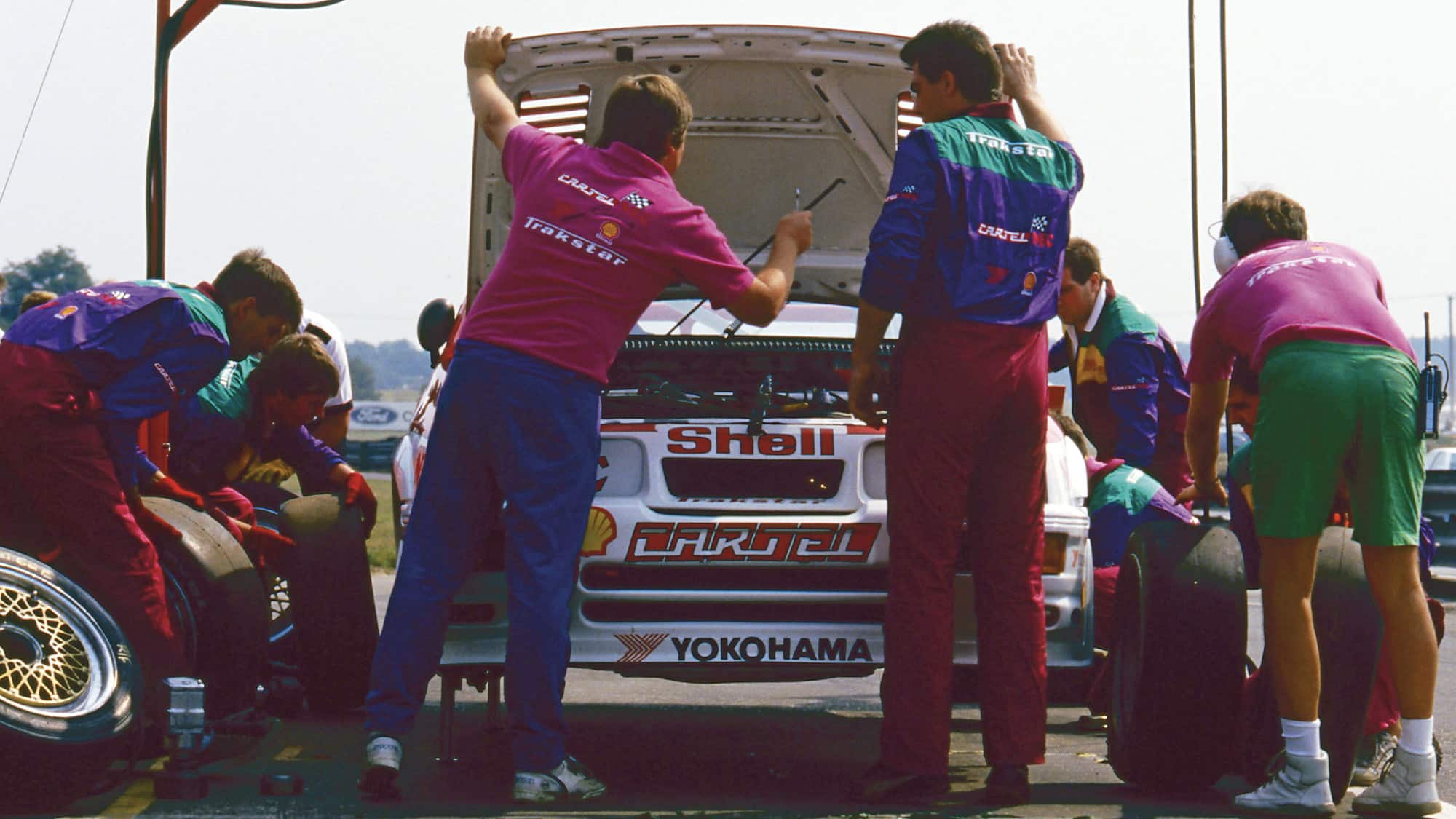
Today, Gravett still hasn’t forgotten the trials of a stressful pair of seasons at Trakstar and recalls the setbacks as well as all the pole positions and race victories: the Brands Hatch night-time paddock fire in 1989 that threatened to destroy not only the team truck, but the racing cars within it; the time he returned from a race weekend to discover his house had been burgled. But there’s pride too in that final title for the RS500, earned the hard way.
“We were the upstarts coming in and beating the establishment,” he says, “plus I was very fortunate to be racing at that time in those cars. The closest thing to them is the Supercar V8s in Australia, but they are still not going as fast down the Conrod Straight at Bathurst. They are doing 185mph and we were doing 189mph. When I raced at Fuji, on my qualifying lap on ‘quallie’ tyres we touched 200mph on the straight. In a touring car.”
But having taken on and conquered the most extreme era of tin-top bump and grind, it’s bizarre that Gravett would never win another BTCC race. As Rouse switched briefly to a two-car campaign with Toyota Carinas – quite a gear change – Trakstar was rewarded with a Ford deal to run a Shell-backed Sapphire. It was a disaster, and Gravett and Trakstar would soon be left for dust, in the wake of a manufacturer-baiting new-look BTCC that would become the envy of the racing world. But 30 years on from his golden season in the spotlight, the man in the bare white Ford should never be forgotten as a primary source of where the buzz began.
RS500 reunited… sort of
Gravett’s restored title- winner is in waiting in Leeds
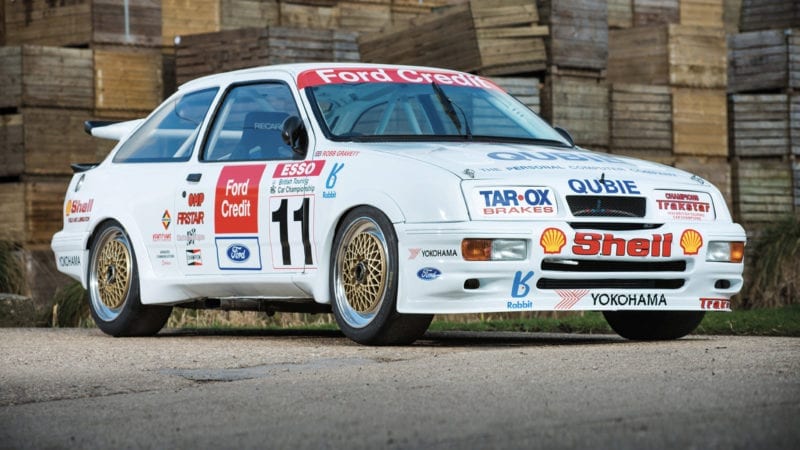
The RS500 has undergone a nut-and- bolt restoration back to standard
Robb Gravett was all set to be reunited with his Trakstar Cosworth RS500 this summer at the Silverstone Classic, only for world events to intervene. The car is currently part of the collection owned by McLaren Racing CEO Zak Brown, who bought it at Silverstone Auctions’ Race Retro sale in 2018 for £182,250. Given its provenance, the 1990 BTCC winner really should go for more when Brown sells it, especially following a thorough restoration.
United Autosports, which Brown co-founded with friend and former racer Richard Dean in West Yorkshire, took on the rebuild of a car that briefly raced in Italy in a garish blue and green livery once Gravett and Trakstar were done with it, before being retired to storage. It was sold in 2014 before Brown snapped it up at auction.
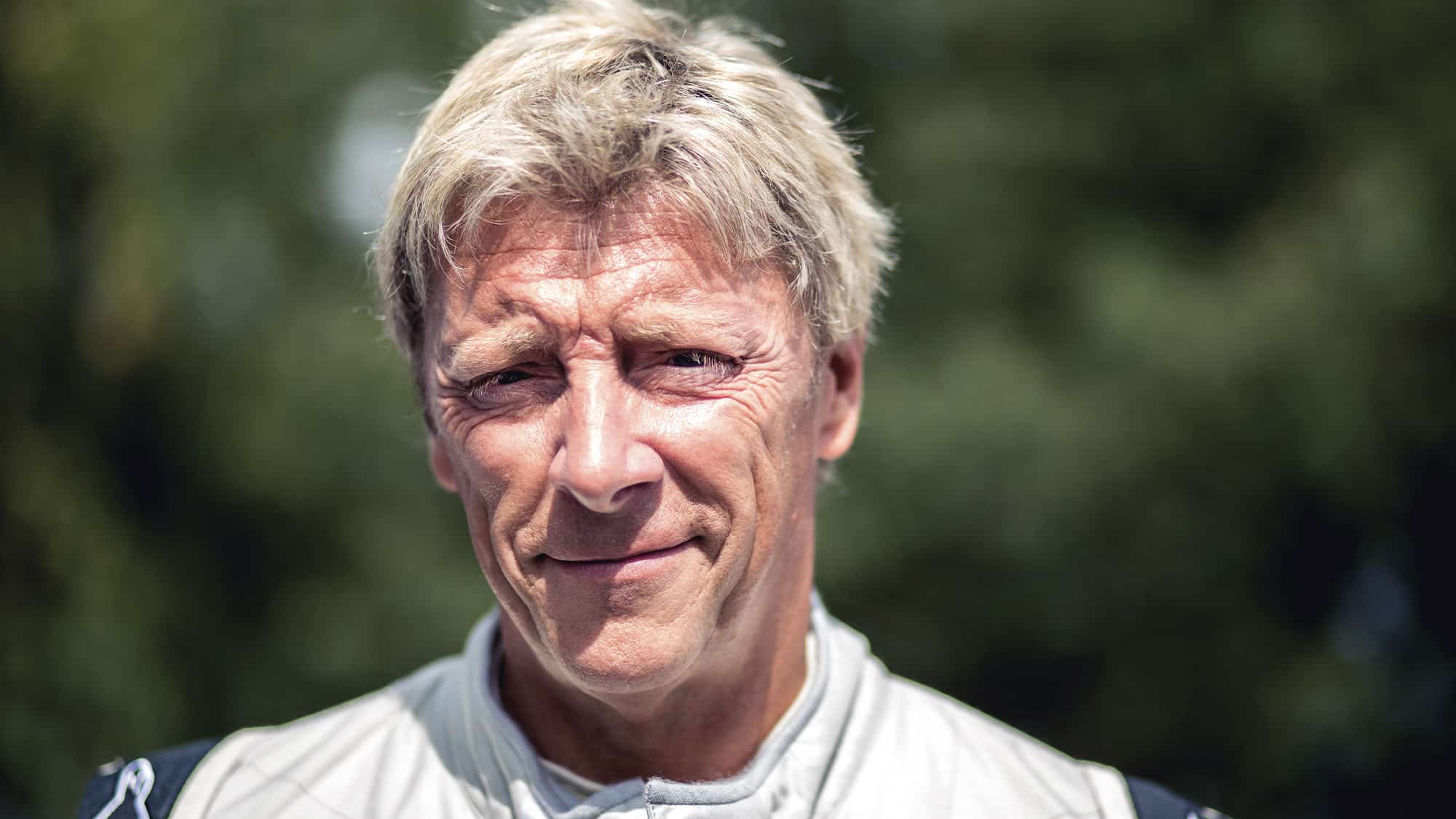
“It looked really good, but when we got into it, it wasn’t,” says United’s Paul Haigh. “It looked immaculate, the bodywork you couldn’t fault. It was just the mechanicals we had to put back to standard. It wasn’t a small job, but we’ve worked hard to bring it back to its absolute original specification and Malcolm Swetnam has been a big help.”
At full 2.5-bar boost and with 560bhp, the Trakstar RS500 would be quite an addition for the HSCC ‘Supertourers’ grids and the Grand Prix Legends Touring Car Challenge. Let’s hope United can reunite Gravett with it somewhere soon.
As seen on TV
Steve Rider recalls the spark that lit the BTCC boom, and how it revolutionised motor sport on TV
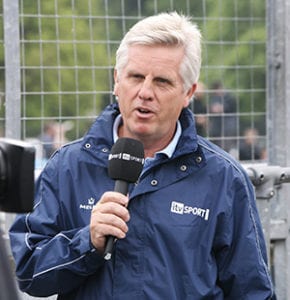
“We were just about getting the hang of the BTCC around 1989/90 at our production company BHP. We’d sold the package to the BBC in 1987. It was myself, Murray Walker and Tiff Needell who sat down with the head of sport and the editor of Grandstand and told them they needed two championships: the BTCC and Formula 3, which was the natural conduit into F1. They said you’ve got to do it independently and raise the money through the championships and we’ll provide the slots on Grandstand. In a way, Grandstand was leaning towards F3 because you were in an era that was giving you Mika Häkkinen, Damon Hill, Paul Warwick and so on. A golden era. In the BTCC you couldn’t work out who was the champion because of the class system, which confused everyone. So it needed a season like 1990 to really establish rivalries and the close racing we are all familiar with. Sadly, the big beast – the RS500 – disappeared after that, but eventually the BTCC emerged stronger.
We had 12 cameras and then sat in the edit suite for three days after every race. The highlights became a compendium of incidents. Murray would come in on the Wednesday and would take two days to dub it to perfection. He’d insist on a very nice hotel in London… and would always say this could never exist as a live sport, which I remind him about often!
Robb Gravett was the forerunner of everything. He was the light and shade, the upstart taking on the grandee, and beating him. In front of camera he’d pour it all out. If he wanted to have a rant about sponsorship, he’d do it there and then and do it very well. Very much in the Jason Plato mould. He was also a bloody good driver, and it’s just a shame he didn’t find the team that could have accommodated him after that. He didn’t get the enduring legacy.
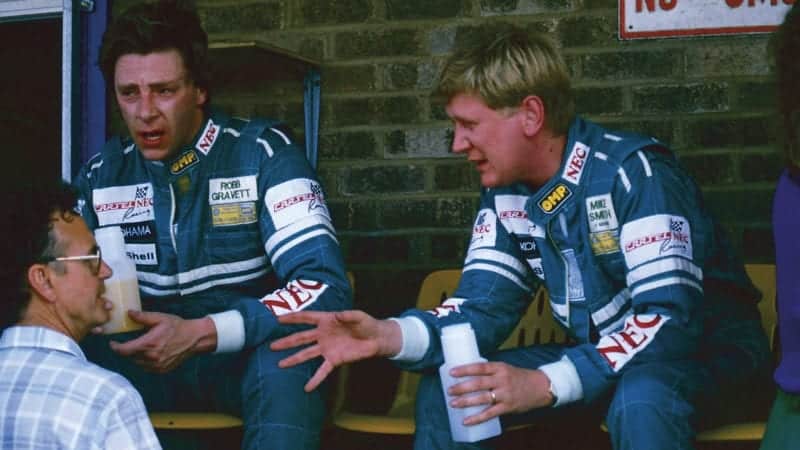
Gravett and Mike Smith (right) made Trakstar
The other ingredient in the background was dear old Mike Smith, who was a better driver than people gave him credit for. Some were a bit sniffy about him, but he was a very important ally in us finding our way around the BBC. He was a TV broadcasting man and he understood what we were trying to do. He was an absolute gent and was on our case that season, asking what they could do to help. I’ve got a soft spot for all he did.”
